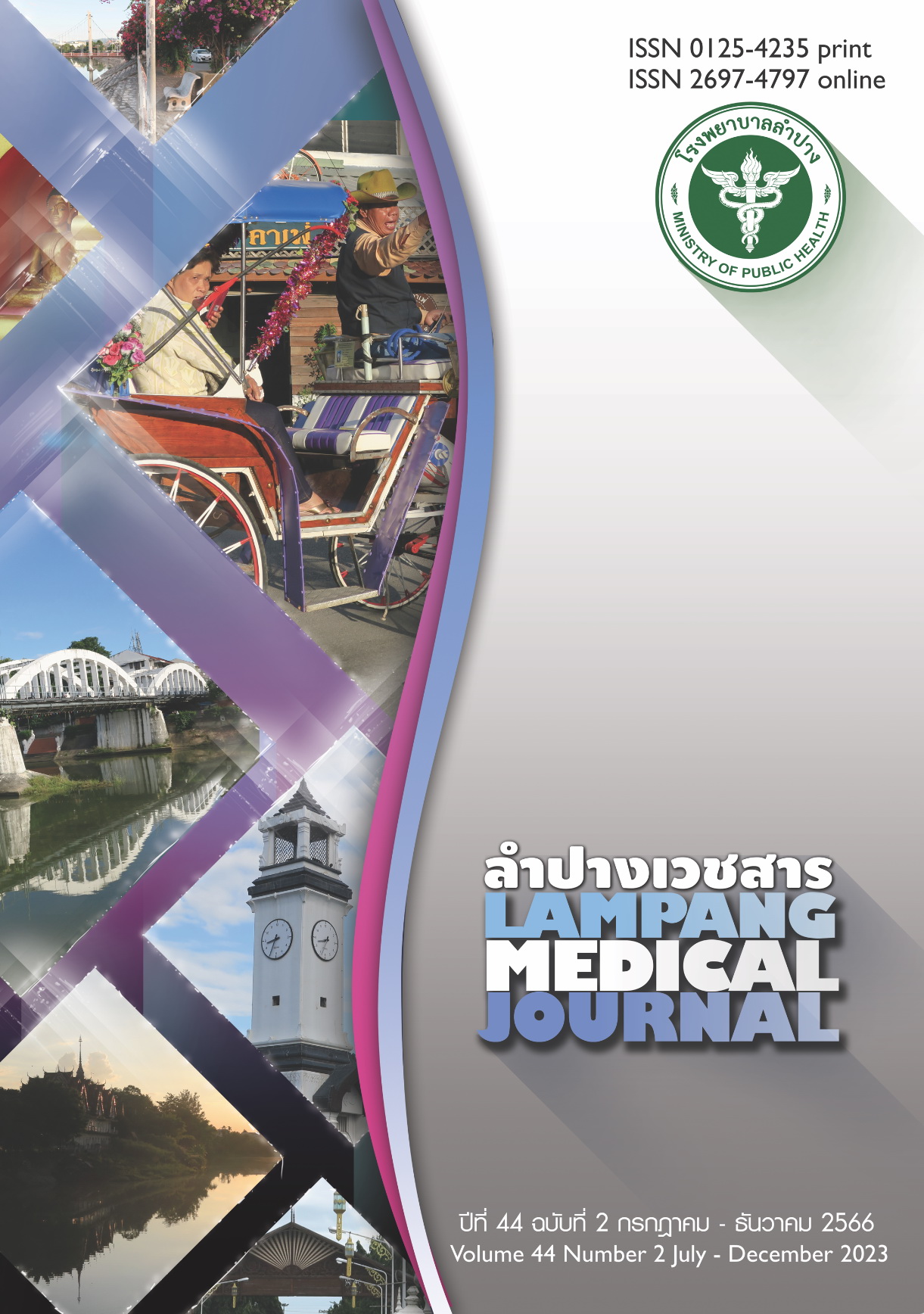Locked versus Nonlocked Percutaneous K-wire Fixation in Distal Radius Fractures Treatment: a Comparative Study for Maintenance of Postoperative Alignment
Main Article Content
Abstract
Background: Distal radius fractures (DRF) are typically treated with percutaneous K-wire fixation and a short-arm slab. Linking all K-wires that were fixed to a fracture site in one system (locked K-wire system) could withstand an immediate physiologic load more than the non-locking system. Whether this system could maintain the fracture alignment until union without immobilization is questionable.
Objectives: To compare the maintenance of radiographic wrist parameters in percutaneous K-wire fixation for closed extra-articular and simple partial intraarticular DRF between locked and nonlocked K-wire systems.
Material and methods: A prospective non-randomized controlled trial was conducted in patients with DRF who underwent percutaneous K-wire fixation at Kamphaengphet Hospital between January and June 2023. Patients were allocated into two groups according to surgeon preference. The study group underwent a locked K-wire system without immobilization, while the control group underwent a nonlocked K-wire system and a short-arm slab. Postoperative wrist radiographs were taken immediately, at 2, 6, and 10 weeks. Wrist parameters (radial height, radial inclination, ulnar variance, and volar tilt) were measured and their differences were calculated with those of the immediate postoperative films. The data were statistically compared between the two groups.
Results: The mean radial height difference, radial inclination difference, and ulnar variance difference of the study group (n=26) were not different from those of the control group (n=31) at 2, 6, and 10 weeks (p<0.05). The mean volar tilt difference of the study group was significantly lower than the control group at 2, 6, and 10 weeks. One patient in the control group had revision surgery.
Conclusion: Using a locked K-wire system without immobilization for percutaneous K-wire fixation in DRF can maintain radial height, radial inclination, and ulnar variance similarly to the nonlocked K-wire system and short arm slab. It also significantly better maintains volar tilt throughout the 10-week follow-up period.
Article Details

This work is licensed under a Creative Commons Attribution-NonCommercial-NoDerivatives 4.0 International License.
บทความที่ส่งมาลงพิมพ์ต้องไม่เคยพิมพ์หรือกำลังได้รับการพิจารณาตีพิมพ์ในวารสารอื่น เนื้อหาในบทความต้องเป็นผลงานของผู้นิพนธ์เอง ไม่ได้ลอกเลียนหรือตัดทอนจากบทความอื่น โดยไม่ได้รับอนุญาตหรือไม่ได้อ้างอิงอย่างเหมาะสม การแก้ไขหรือให้ข้อมูลเพิ่มเติมแก่กองบรรณาธิการ จะต้องเสร็จสิ้นเป็นที่เรียบร้อยก่อนจะได้รับพิจารณาตีพิมพ์ และบทความที่ตีพิมพ์แล้วเป็นสมบัติ ของลำปางเวชสาร
References
Sander AL, Leiblein M, Sommer K, Marzi I, Schneidmüller D, Frank J. Epidemiology and treatment of distal radius fractures: Current concept based on fracture severity and not on age. Eur J Trauma Emerg Surg 2020;46:585–90.
Chung KC, Spilson SV. The frequency and epidemiology of hand and forearm fractures in the United States. J Hand Surg Am 2001;26:908–15.
Koo OT, Tan DM, Chong AK. Distal radius fractures: An epidemiological review. Orthop Surg 2013;5:209–13.
Chan YH, Foo TL, Yeo CJ, Chew WY. Comparison between cast immobilization versus volar locking plate fixation of distal radius fractures in active elderly patients, the Asian perspective. Hand Surg 2014;19:19-23.
Ng CY, McQueen MM. What are the radiological predictors of functional outcome following fractures of the distal radius? J Bone Joint Surg Br 2011;93:145-50.
Rozental TD, Blazar PE, Franko OI, Chacko AT, Earp BE, Day CS. Functional outcomes for unstable distal radial fractures treated with open reduction and internal fixation or closed reduction and percutaneous fixation. A prospective randomized trial. J Bone Joint Surg Am 2009;91:1837-46.
Rodriguez-Merchan EC. Plaster cast versus percutaneous pin fixation for comminuted fractures of the distal radius in patients between 46 and 65 years of age. J Orthop Trauma 1997;11:212-7.
Subramanian P, Kantharuban S, Shilston S, Pearce OJ. Complications of Kirschner-wire fixation in distal radius fractures. Tech Hand Up Extrem Surg 2012;16:120-3.
Franceschi F, Franceschetti E, Paciotti M, Cancilleri F, Maffulli N, Denaro V. Volar locking plates versus K-wire/pin fixation for the treatment of distal radial fractures: a systematic review and quantitative synthesis. Br Med Bull 2015;115:91-110.
Meng H, Xu B, Xu Y, Niu H, Liu N, Sun D. Treatment of distal radius fractures using a cemented K-wire frame. BMC Musculoskelet Disord 2022 Jun 20;23:591.
Sanders L, Johnson N, Dias JJ. Kirschner wire fixation in dorsally displaced distal radius fractures: a biomechanical evaluation. J Wrist Surg 2021;11:21–7.
Günay C, Öken ÖF, Yavuz OY, Günay SH, Atalar H. Which modality is the best choice in distal radius fractures treated with two different Kirschner wire fixation and immobilization techniques? Ulus Travma Acil Cerrahi Derg 2015;21:119–26.
Chia B, Catalano LW 3rd, Glickel SZ, Barron OA, Meier K. Percutaneous pinning of distal radius fractures: an anatomic study demonstrating the proximity of K-wires to structures at risk. J Hand Surg Am 2009;34:1014-20.
Walenkamp MM, Vos LM, Strackee SD, Goslings JC, Schep NW. The unstable distal radius fracture-how do we define it? A systematic review. J Wrist Surg. 2015;4:307–16.
Rabie H, Angelliaume A, Nabian MH, Sharafi MH. A stepwise approach for interpretation of wrist x-ray: a practical guideline. J Orthop Spine Trauma. 2020;4:26-31.
Naito K, Kawakita S, Nagura N, Sugiyama Y, Obata H, Goto K, et al. Locked wires fixator for fractures of the distal third of the radius and ulna in children. Eur J Orthop Surg Traumatol. 2020 Oct;30(7):1193-97.
Dias R, Johnson NA, Dias JJ. Prospective investigation of the relationship between dorsal tilt, carpal malalignment, and capitate shift in distal radial fractures. Bone Joint J. 2020;102-B(1):137-43.


